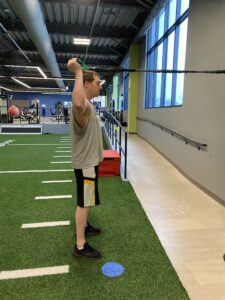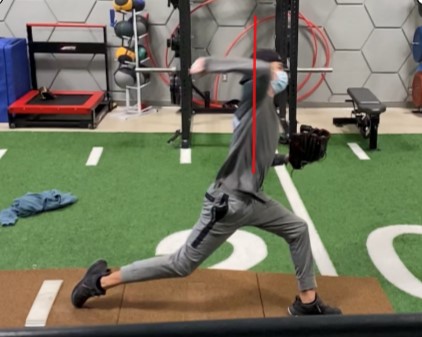Shoulder Centralization - are you inline?
Have you ever shot a firearm with iron sights? If you have, you know that the rear and front sight have to be lined up for the shot to go in the right direction. If the sights are offline, the outcome you want, hitting the target, does not happen. This is similar to shoulder centralization in relation to shoulder health in pitching.
As our arm travels through its path to early cocking/stride foot contact position, we want to optimize getting our arm into an abducted, horizontal abducted, and externally rotated position that also has good scap load (shoulder blade squeezed toward our spine). This process is sometimes aided with coaches cueing to pull or drive your elbow back as you come out of your hand break. While well intentioned, this cue often leads to decentralization of the shoulder and increased anterior shoulder joint stress.
The easy way to think about this is to place your arm in the 90/90 position and see if you are inline from your shoulder to your elbow. When some resistance is placed to challenge the rotator cuff and posterior shoulder, this will exacerbate the problem if you have one. See pics below for what can happen and what is correct.


Through the pitching motion, shoulder centralization is important, but will not be perfectly maintained. Note how my elbow nearly gets in front of my nose in the wrong photo, but is maintained in the correct, this is most closely mimicked in the max external phase of the pitch. This also leads to the correct transfer of energy through the shoulder and elbow to the ball. When out of centralization, typically the elbow tries to make up the deficit and you will see a “tricep push” kind of throw. Below is a collegiate pitcher I had after a surgery and helping him get back to the mound. Look at the red line through the shoulder and notice on day 1 how much further his elbow was from his shoulder at max layback. His body was trying to protect by pushing the ball with the triceps, but this was placing a higher amount of stress on the elbow, and velocity was poor. On the last day, he was more centralized, has increased layback, and velocity was nearing speeds close to preinjury levels.


The article listed at the start helps us better understand that elbow valgus stress (bad) is better controlled with centralized elbow to shoulder, and higher level of stress happens with the “triceps push” position. This stress is also called valgus extension overload, and to minimize this deficit I wanted to give you 2 drills to help improve your scap load and centralization. See below for tutorial video, and these are easily incorporated for warm up or workouts. And as always, feel free to contact me or schedule a zoom call for 1 on 1 coaching.
Dr. David Klaus, DPT, ATC/L
The Pitching Mechanic
Prone Scap Load Hurdles: Use baseball or like item to create your hurdle. Drive shoulder blade back toward spine to raise hand then move over the hurdle. Go up and down the ladder 5 times and perform 2 sets. Start with once a day to learn, but can use for warm up prior to throwing or before overhead lifts after you get the feel for it.
External Rotation Plyo Drops: Perform your scap load and externally rotate your shoulder, trying to keep elbow and shoulder inline. Quickly drop and catch the ball in this position for 10-30 seconds. Start with 2-3 sets and perform 2-3 times a week.